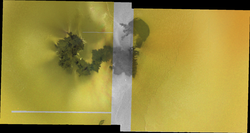Prometheus (volcano)

Prometheus is an active volcano on Jupiter's moon Io. It is located on Io's hemisphere facing away from Jupiter at 1°31′S 153°56′W / 1.52°S 153.94°W.[2]
Description
[edit]Prometheus consists of a 28-kilometer-wide (17 mi) volcanic pit named Prometheus Patera and a 100-kilometer-long (62 mi) compound lava flow, all surrounded by reddish sulfur and circular, bright sulfur dioxide (SO
2) volcanic plume deposits.[3] The volcano was first observed in images acquired by the Voyager 1 spacecraft in March 1979.[4] Later that year, the International Astronomical Union named this feature after a Greek fire god, Prometheus.
Prometheus is the site of a volcanic eruption that has been ongoing since at least the Voyager 1 encounter in 1979. Between the Voyager encounters and the first observations by Galileo, a 6,700-square-kilometer (2,600 sq mi) flow field was emplaced.[5] Later Galileo observations of this flow field revealed numerous small breakouts, particularly on the western end of the flow field.[6]
Prometheus is the site of two volcanic eruption plumes: a small, sulfur-rich plume erupting from the magma-source vent at the eastern end of the flow field and a 75-to-100-kilometer-tall (47 to 62 mi), SO
2-rich dust plume erupting from the active flow front at the other end.[3] The former forms a diffuse, red deposit to the east of the Prometheus flow field. The latter forms a bright, circular deposit surrounding the entire volcano and lava flow. The SO
2-rich plume is generated as lava at the western end of the flow field covers sulfur dioxide frost, heating and vaporizing it.[7] This is accomplished at multiple breakouts, generating gas and dust for the visible dust plume.[8] Prometheus' plume has been observed by both Voyager spacecraft, Galileo, and New Horizons, at every appropriate imaging opportunity.
References
[edit]- ^ Leone, G.; Gerard Davies, A.; Wilson, L.; Williams, D. A.; Keszthelyi, L. P.; Jaeger, W. L.; Turtle, E. P. (2009). "Volcanic history, geologic analysis and map of the Prometheus Patera region on Io". Journal of Volcanology and Geothermal Research. 187 (1–2): 93–105. Bibcode:2009JVGR..187...93L. doi:10.1016/j.jvolgeores.2009.07.019.
- ^ Blue, Jennifer (October 1, 2008). "Io Nomenclature: Eruptive center". USGS. Archived from the original on 2006-10-02. Retrieved 2008-10-01.
- ^ a b Davies, A. (2007). "Prometheus and Amirani: effusive activity and insulated flows". Volcanism on Io: A Comparison with Earth. Cambridge University Press. pp. 208–216. ISBN 978-0-521-85003-2.
- ^ Smith, Bradford A.; et al. (1979). "The Jupiter system through the eyes of Voyager 1". Science. 204 (4396): 951–972. Bibcode:1979Sci...204..951S. doi:10.1126/science.204.4396.951. PMID 17800430. S2CID 33147728.
- ^ McEwen, A. S.; et al. (1998). "Active Volcanism on Io as Seen by Galileo SSI". Icarus. 135 (1): 181–219. Bibcode:1998Icar..135..181M. doi:10.1006/icar.1998.5972.
- ^ Keszthelyi, L.; et al. (2001). "Imaging of volcanic activity on Jupiter's moon Io by Galileo during the Galileo Europa Mission and the Galileo Millennium Mission". J. Geophys. Res. 106 (E12): 33025–33052. Bibcode:2001JGR...10633025K. doi:10.1029/2000JE001383.
- ^ Kieffer, Susan W.; et al. (2000). "Prometheus: Io's Wandering Plume". Science. 288 (5469): 1204–1208. Bibcode:2000Sci...288.1204K. doi:10.1126/science.288.5469.1204. PMID 10817989.
- ^ Milazzo, M. P.; et al. (2001). "Observations and initial modeling of lava-SO
2 interactions at Prometheus, Io". J. Geophys. Res. 106 (E12): 33121–33128. Bibcode:2001JGR...10633121M. doi:10.1029/2000JE001410.

